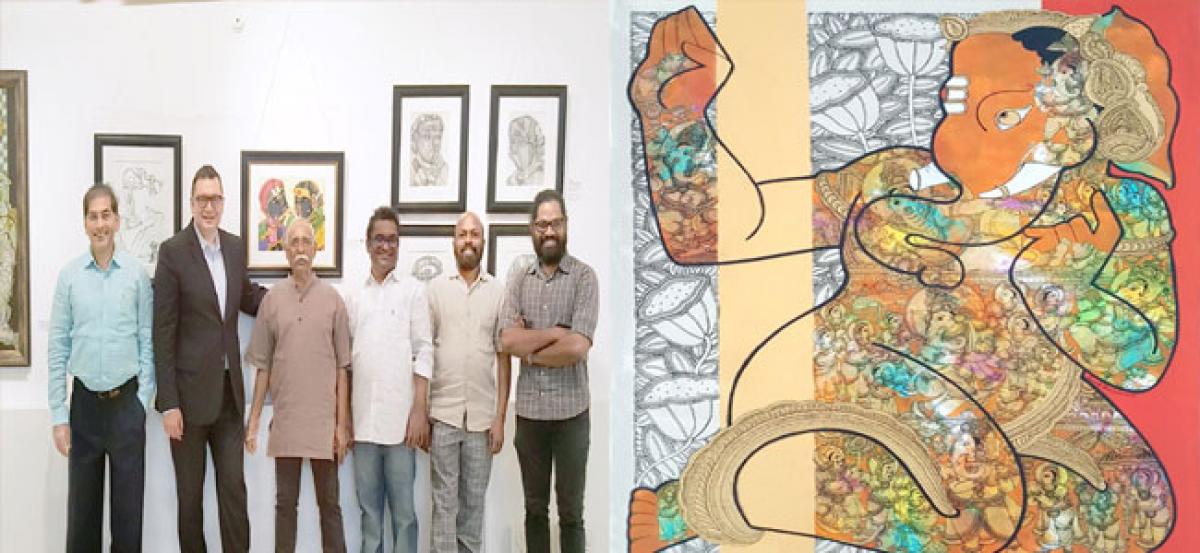Live
- 20 killed after boat capsize in Cameroon
- Share market opens in green, media and pharma stocks shine
- Gold rates in Delhi today surges, check the rates on 29 November, 2024
- Gold rates in Hyderabad today surges, check the rates on 29 November, 2024
- Gold rates in Vijayawada today surges, check the rates on 29 November, 2024
- Gold rates in Visakhapatnam today surges, check the rates on 29 November, 2024
- Gated communities care two hoots about SEEEPC survey in Hyderabad
- Chandrababu to visit Anantapur for NTR Bharosa pension fistribution tomorrow
- RR dist registers 91.6% survey completion rate
- Ex CID chief has biz links in Dubai, alleges Dy Speaker RRR
Just In

Artist Ramesh Gorjala completed his studies from JNTU Hyderabad. His work focuses on traditional Indian heritage and culture, through sensitive and detailed mythological portrayals of various Indian gods and goddesses.
Artist Ramesh Gorjala completed his studies from JNTU Hyderabad. His work focuses on traditional Indian heritage and culture, through sensitive and detailed mythological portrayals of various Indian gods and goddesses.
The style and diction of artist Ramesh Gorjala have come a long way from where it started. The inspiration from ‘Kalamkari’ tradition had initiated a creative path for him, which he has further developed into a personal visual language and expression.
He works with a delicate and intricate technique, portraying his spiritual take on the subjects of Indian mythology through both his imagery and his process. His use of a palette dominated by gold, red and green creates a very rich and natural feel in each of his paintings and the moods that he can create and convey add an antiquated yet contemporary dynamic to his work.
In the present series, he has worked with vertical panels of colour areas that divide the space into rectangular sections. In some of these, the artist chooses to work with limited palette and drawing. This aspect grants his work an essence of ‘twinkling’ where the light and spark shifts from one vertical block to another, thus also infusing a sense of movement of energy from one section to another.
He shares, “In one of the works, ‘Kamdhenu’ is depicted along with all the strengths it is believed to imbibe. The form spans throughout the available space and spreads almost to the extremities of the pictorial surface. The simplified representation of the beloved, auspicious animal in a single, bold sweeping line is in contrast with the intricate, fine and detailed tales in the background,”
The legendary artist Thota Vaikuntam hails from Andhra Pradesh and finds his inspiration in the rural areas of the state. Men and women of his village are often the central characters of his work.
Telangana women are frequent subjects for his works. The obsession can be traced back to his childhood when he used to be fascinated by the male artists who used to impersonate female characters in the traveling theatre groups that performed in his village. He admits on finding the women of his village very sensuous and that he only attempts to capture their vibrancy.
His art has a sense of strength to it, a power that emanates from the paint or charcoal that he applies to the surface, from his controlled lines, and from the fine strokes that he executes. He generally uses only primary colours, as he believes that composite colours do not exist in nature and are, therefore, unnatural.
As he explains, “I like using rich primary colours, which give a sense of character and depth to my paintings; colours like red, saffron and even orange because these are essentially Indian colours. I don't like using colours that are a mix of two because they are not natural, they don't exist in surroundings around us, in our everyday life,”
His works recreate the self-satisfied, unpretentious and natural grace of the village folk.
It is their disregard to look good that makes them more appealing and intriguing. The traditional attires, ornaments, and surroundings are blended with modernist and contemporary aspects of expression. The black and white drawings reinstate the mastery and control of the artist over ‘line’ as well as there are some areas where ‘line’ is allowed to move in long sweeps, but always in sync with the artists' idea and creative intent.
The granular texture of charcoal accelerates the rustic ethos and charm. The colour palette is rich in bright hues that are prominently present and overwhelmingly reign over
Indian rural life.
What: Dual Art show
When: Until April 6 between 11.30am and 7pm
Where: Gallery Space, Banjara Hills

© 2024 Hyderabad Media House Limited/The Hans India. All rights reserved. Powered by hocalwire.com







